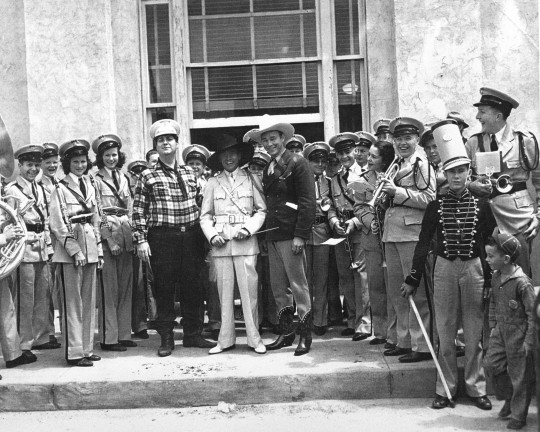This article originally appeared in the Garland/Mesquite section of The Dallas Morning News on December 8, 1995.
By Michael R. Hayslip
In the broad scope of things the most significant celebrity to visit Garland so far may have been Leonard Slye, better known as Roy Rogers, King of the Cowboys.
While the city has also hosted such national notables as then-Congressman Lyndon Johnson, segregationist Governor Orville Faubus, First Lady Roslynn Carter, concert pianist Van Cliburn and armadillo master Willie Nelson, none of these has yet equaled Roy Rogers’ positive role influence over generations of Americans.
With neither political clout nor the taint of civil disobedience, domestic intrigue or substance abuse, he held his position on high moral ground with minimal violence. Nevertheless, he edged out Gene Autry, and from 1943 to 1954 Roy Rogers was Hollywood’s number one money-making star. Truth be known, his trusty mount Trigger may have even inspired other horses to better behavior.
Roy Rogers’ act played especially well in Garland, a dry town where King James Bibles were best sellers and the local newspaper’s masthead bore the inscription “Dedicated to the Best Moral and Financial Interests of Garland and Communities.”
Happy Trails, the story of Roy Rogers and Dale Evans by Dallas Morning News writer Carlton Stowers, reveals that on his first visit, Tuesday, April 19, 1938, the 27-year-old Rogers was a little-known quantity -- in Garland or anywhere else. He arrived on a whirlwind promotional tour to plug his first starring role in Under Western Stars, originally reserved for Gene Autry and opening at the Capitol Theatre in Dallas.
Mr. Autry and Republic Studios had fallen out over a contract dispute, giving Leonard Slye his big chance, a new name and the services of Smiley Burnett, the veteran Autry sidekick. The King of the Cowboys also received $75 a week and a clean white hat -- a big jump over his rewards for the previous seven years as a traveling singer and bit-part actor, before which he had been a shoe-factory worker in Ohio and a fruit picker in California. He smiled a lot in 1938, and Under Western Stars was eventually voted the best western of the year.
What the locals did know was that real-live movie stars had dropped by in the middle of The Great Depression. Although Garland and the surrounding area still had enough agricultural connections to cushion most residents from the worst of the country’s hardships, the Rogers-Burnett show provided a welcome morale boost, and obliging crowds of all ages thronged the Hollywood entourage as it appeared on the town square.
The festivities, complete with high school band, Mayor J. A. Alexander and other dignitaries, were endorsed by the entire Garland business community, 95 per cent of which was located around the town square. H. R. Bisby and his wife Jennie, who owned the Garland Theatre on Bankhead Avenue (now Main Street), where the new film was scheduled to run, were presumably parties to Republic’s ploy to thumb their new star at Gene Autry. A collection of theatre mementos from the Bisbys, including photos of Roy Rogers’ visits, is on display at the central branch of Garland’s Nicholson Memorial Library.
Howard Taylor, school band director at the time, recalls that the convocation occurred slightly before noon and was populated by a suspicious number of school-age youngsters Mr. Rogers would come to call “buckaroos.” “The Hollywood folks acted like they were in a big hurry to move on to the next stop,” said Mr. Taylor.
But despite the commotion, The Garland News management was far too shrewd to be duped by a publicity stunt for any flash-in-the-pan actor, and the paper restricted its photo-journalistic coverage of Roy Rogers to a three-by-four-inch spot on Page Two of the week’s edition. Some suspected Gene Autry sympathies on the part of the News’ publisher.
The Happy Trails of Roy Rogers crossed Garland at least once more after the 1938 visit, but his tracks are now faded. A wartime visit, restrained due to the circumstances, occurred about 1944, when he made a defense-factory tour of the Continental Motors plant (now Kraft Foods).
It was probably on that occasion that Mr. Rogers, world-famous by then, was photographed with his new sidekick, George “Gabby” Hayes and Mr. Bisby in what appears to be Mr. Bisby’s home on Avenue E. Gabby Hayes had joined the duo in 1939, since Smiley Burnett, after an querulous stint with William “Hopalong Cassidy” Boyd, had returned to the side of his old pal Gene Autry. Dale Evans became a part of the Rogers cinema team in 1944.
Photos courtesy John D. Skelton, II
Photo caption:
(Band Scene) Band Director Howard Taylor and Smiley Burnett switch hats as they stand with the bank alongside Roy Rogers in 1938. Those visible with the group in front of Nicholson Memorial Hall include (l-r): Bill Matthews, Sam Wilhoit, Lorene and Florene Coyle, John Duke, Mr. Burnett, Frank Greenhaw, Mr. Taylor, (unidentified), Mr. Rogers, (unidentified), Paul Buhler, Arthur Buhler, Minor Nickens, (unidentified), Sidney Thompson, (unidentified), Jimmy Davie, Lon Morris Pace and an unidentified boy.
Photo not available
(Interior group) Plaza Theatre owner H. R. Bisby (l) and Gabby Hayes (with beard) are shown with Roy Rogers and two unidentified guests on a Garland tour during World War II.
(Street Scene) Garland stages a big welcome for Roy Rogers and Smiley Burnett in 1938 on their tour to promote Under Western Stars. Mr. Burnett, who was better known at the time, is listed first and larger on the banners.



